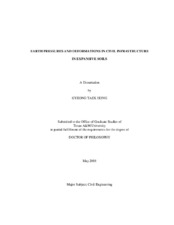| dc.description.abstract | This dissertation includes the three major parts of the study: volume change, and lateral
earth pressure due to suction change in expansive clay soils, and design of civil
infrastructure drilled pier, retaining wall and pavement in expansive soils.
The volume change model in expansive clay has been refined to reinforce
realistic characteristics of swelling and shrinkage behavior of expansive clay soils.
Refinements include more realistic design soil suction versus depth profiles and
improved characterizations of the effects of soil cracking, overburden stress, and lateral
earth pressure. The refined model also includes an algorithm of assigning suctionvolumetric
water content curves and diffusivity through the soil.
The typical lateral earth pressure distribution during wetting against a stationary
wall is proposed. The proposed stationary retaining wall-soil system in expansive soils
includes an upper movement active zone and a lower anchor zone. Mohrâ s circles and
failure envelopes are used to define the effective horizontal stress and shear failure in an
unsaturated soil. The prediction of the horizontal pressures due to suction change in a
soil is compared with the in situ measurement of natural horizontal pressures and the
measurements from the large scale tests. It is found that agreement between the
measured and predicted horizontal pressures is satisfactory. Case studies of axial and
bending of the pier are presented with both uniform and non-uniform wetting. The pier case study for axial behavior shows a good agreement with a heave at ground surface
and uplift forces. Three case studies for bending behavior of the pier and retaining wall
are presented based on suction change.
Pavement design program has been refined to extend the design capabilities into
both flexible and rigid pavements supported by pavement treatments. The comparative
case studies using both current and new methods in pavement design show that the
current method criterion of 1-inch is unnecessarily conservative. Furthermore, the
current method does not provide a means of anticipating subgrade shrinkage that will
result in longitudinal cracking along the edge of the pavement. The design calculations
with both methods lead to the conclusion that neither the swelling movement, as in the
current method, nor the total movement, as in the new method, is a reliable indicator of
likely acceptable pavement performance. Instead, all of these case studies show that it is
important to use the predicted history of the present serviceability index and the
international roughness index as the proper design guideline for an acceptable treatment
of the subgrade of an expansive soil. | en |


